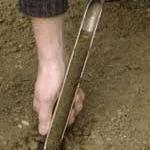Sampling Soils for Meaningful Results
Introduction
The objectives of soil testing are to accurately determine the status and availability of nutrients, and to clearly indicate any deficiency or excess that may exist. Soil test results can be used to determine specific crop nutrient needs for profitable and environmentally sound application of fertilizer, lime, and organic soil amendments including manure or compost. Applying fertilizer or manure without the benefit of a good soil test is like throwing money away. Without the proper guidance of a soil test, the farmer could lose profit due to lower yields or from unnecessary expenditures.
Four Steps of Soil Testing
- Collect the soil samples
- Analyze the sample
- Interpret the results
- Make fertilizer and lime recommendations
The first step is the responsibility of the farmer while the next three are performed by a soil testing lab. Each step is important for meaningful results.
Collection of soil samples from a field
Taking a soil sample truly representative of a field's characteristics is very important. Poor sampling gives misleading test results. Large differences are often found the same field. These differences usually are not sampling or testing errors but are actual variations in fertility patterns. To minimize the effect of these inherent fertility differences, this established sampling procedure should be followed:
- The closer the samples are taken to planting time, the less chance there is for changes to occur. Nitrogen levels tend to vary a lot so sampling near the time of planting is best. However, soil samples may be taken either in the fall or spring. Fall sampling ensures that test results are ready in plenty of time for spring or for fall fertilization when weather conditions are good and time is not so critical.
- Take soil samples every 2-3 years. Keep a record of soil test results on each field to evaluate long term trends in nutrient levels.
- Each soil sample should be a composite of soil cores taken from a similar area. When sampling, avoid unusual areas such as eroded sections, dead furrows, flooded areas, fertilizer bands, and fence lines. Divide each field into uniform soil and past cropping areas.
- Assign a permanent identification name/number for long-term record keeping. Fertility trends over a period of years provide important information, indicating the adequacy of a fertilizer program (too much, too little, or the correct amount).
- To sample an area of one soil type, take at least 15-20 small samples or cores at random from each area to give a composite sample at tillage depth (upper 6-8 inches for most crops). For perennial pastures or hay crops (cases where the soil is not annually mixed), sample only to 4 inches deep.
- Use a soil probe or soil auger to collect the samples (see the image above). You can also use a shovel or spade for shallow samples.
- The subsamples should be collected into a clean plastic container and mixed together well.
- From this composite sample remove about a cup of soil and allow it to air drywithin12 hours of sampling. Place the sample into a Zip-Lock bag for shipping. Label the outside of the bag with your name, address, field, and intended crop.
Resources
Soil samples can be sent through standard mail services to UMass Soil Testing Lab, West Experiment Station, UMass, Amherst, MA 01003. For further information contact the Soil Test Lab (413-545-2311).
For testing services and price list log on to: https://ag.umass.edu/services/soil-plant-nutrient-testing-laboratory
For results and interpretation of soil test see the UMass Extension Soil and Plant Nutrient Testing Laboratory
Note: Accurate soil tests are important for a successful nutrient management plan.
Note: Soil tests are required every three years.
Factsheets in this series were prepared by Stephen Herbert, Masoud Hashemi, Carrie Chickering-Sears, and Sarah Weis in collaboration with Ken Miller, Jacqui Carlevale, Katie Campbell-Nelson, and Zack Zenk.
This publication has been funded in part by Mass. Dept. of Agricultural Resources in a grant to the Massachusetts Farm Bureau Federation, Inc. and by Mass. Dept. of Environmental Protection, s319 Program.
